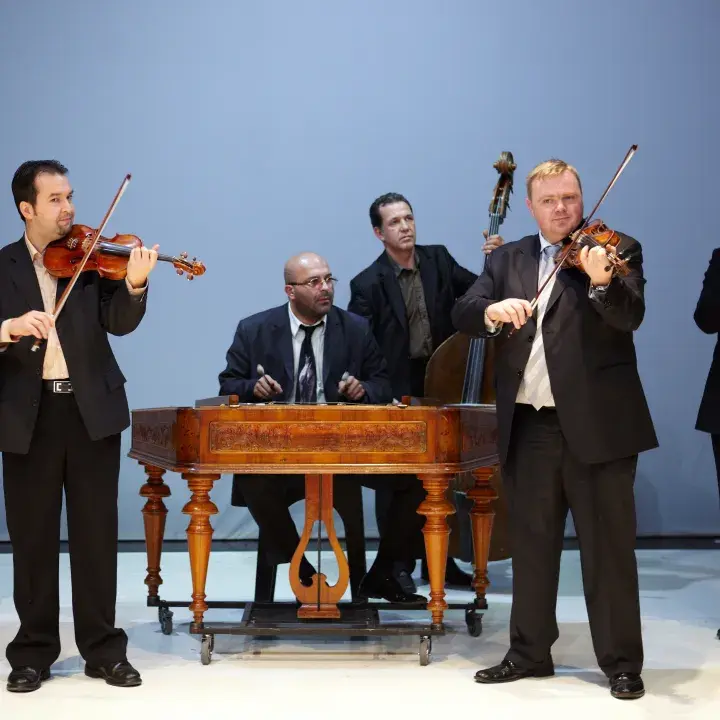The Orchestra of the Hungarian State Folk Ensemble plays the most famous tunes of the 19th and 20th century and folk music from different regions of the Carpathian Basin. Beside the classic string instruments (violin, viola, double-bass), authentic folk instruments such as bagpipe, taragot, cymbal and hit-gardon can be heard. This amusing concert presents the musical world of the huge "melting-pot" in which such outstanding musical values could develop. From Transylvanian dance music through the 'verbunk' or Brahms's Hungarian Dances to the music of the recently deceased Csángó fiddler, János Zerkula - these tunes still define the music of the Carpathian Basin.
Part I
'Dense' and 'loose' men's dance from Bonchida (Bonţida, Transylvania)
As a Hungarian proverb says: "There was a huge feast all the way from Hencida to Bonchida." These two villages lie some 230 km (140 miles) apart, now on two different sides of the Hungarian border. The elegant and sophisticated dance music of Bonchida village is an outstanding piece of Hungarian folklore.
Brahms: Hungarian Dance No. 5
The best known piece of Brahms's popular "Hungarian Dances" series, presented in a way Brahms would have heard it reproduced by contemporary Gipsy musicians at a café.
17th cent. revolutionary tunes on taragot
The Hungarian wind instrument taragot (tárogató) became historically connected to the 17th and 18th century Hungarian revolutionary movements against the Hapsburg monarchy. The taragot's unique, bittersweet voice became a symbol of Hungarian independence movements ever since.
János Bihari: Coronation verbunk
János Bihari was an influential musician at the end of the 18th century. This piece became an emblem of the Hungarian 'verbunk' (recruitment music and dance) genre.
From Vienna, West to East (Southern Slovakia)
A musical reminiscence of the 1848-49 Hungarian Revolution and War of Independence.
Pictures from the Austro-Hungarian Monarchy
This piece dates back to the times when Budapest was a popular cultural entrainment resort among the Viennese.
Morning song, czardas and 'swift dance' from the Kalotaszeg region (Transylvania)
The genre of the morning song originates form the pagan tradition of greeting the rising sun. This song is followed by popular dance tunes from the Kalotaszeg region
BREAK
Part II
Gipsy dance music from Szászcsávás (Ceuaş) and Őrkő (Sfântu Gheorghe) Transylvania
Two virtuoso pieces from Transylvanian gipsy settlements.
Franz Liszt: Hungarian Rhapsody No. 2
Liszt's rhapsodies, inspired by contemporary urban gipsy musicians, became exemplary pieces of 19th century Romantic Hungarian patriotism.
Tunes from the Felcsík region (Transylvania)
The inhabitants of this region are the Székelys (Seklers), a special ethnic group within the Hungarian nation. The roughness of their natural surroundings is well reflected in their music, which however does not lack playfulness either. The Felcsík Székelys' characteristic rhythm instrument is the hit-gardon.
Romanian tunes for cymbal
The popularity of the Hungarian cymbal surpassed the borders of 19th century Hungary. This is a selection of cymbal pieces from Moldova and Walachia, the areas of Romania beyond the Carpathians.
Wedding procession music from Bonchida (Bonţida, Transylvania)
On her way to the church, the bride and her family usually received musical accompaniment. This tradition led to the birth of several magnificent and sorrowful songs about parting with one's home, parents and maiden friends.
Finale
Musical jokes had been popular genres in times past. The concluding piece of this night is such a joke, themed on the music of Emir Kusturica's movies.

